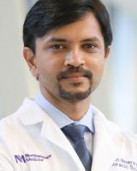
Dr. Ankit Bharat
Corresponding author
Professor of thoracic surgery at Northwestern University Feinberg School of Medicine and executive director of the Northwestern Medicine Canning Thoracic Institute
New Northwestern Medicine study provides answers and drug targets
CHICAGO --- More than 50% of lung-transplant recipients experience a rejection of their new lung within five years of receiving it, yet the reason why this is such a prevalent complication has remained a medical mystery.
Now, a new Northwestern Medicine study has found that, following transplant and in chronic disease states, abnormal cells emerge and “conversations” between them drives the development of lung damage and transplant rejection.
These findings not only help answer why rejection occurs, but they also have spurred immediate exploration of new drugs to treat transplant rejection and other lung-scarring diseases.
“Chronic lung-transplant rejection has been a ‘black box.’ We knew it happened but did not exactly know why,” said corresponding author Dr. Ankit Bharat, professor of thoracic surgery at Northwestern University Feinberg School of Medicine and executive director of the Northwestern Medicine Canning Thoracic Institute. “Our study provides the first comprehensive cellular and molecular roadmap of the disease.”
The study was published Oct. 22 in JCI Insight.
Surgeons perform approximately 3,000 to 3,500 lung transplants each year in the U.S., and more than 69,000 have been performed worldwide to date. Chronic lung allograft dysfunction (CLAD), which encompasses several manifestations of chronic lung rejection, remains the leading cause of death after the first year of transplantation. There currently are no effective treatments for CLAD once it develops, leaving patients with only one option: re-transplantation.
In the new study, after evaluating almost 1.6 million cells, scientists distinguished between abnormal cells from the donor lung versus cells from the recipient’s own immune system. They discovered the donor-derived structural cells and recipient’s immune cells talk to each other in harmful ways that perpetuate lung damage. The findings could lead to new drug targets and provide insights that could help patients with various lung-scarring diseases, not just transplant recipients.
The scientists discovered a rogue cell type (KRT17 and KRT5 cells) that drives lung scarring across multiple diseases, including idiopathic pulmonary fibrosis, interstitial lung disease, COPD, COVID-19 lung damage and transplant rejection. By integrating data from this array of scarring lung diseases, the scientists created the first comprehensive reference map showing which molecular features are shared across conditions and which are unique to each disease.
“By comparing chronic rejection to other scarring lung diseases, we identified both shared and unique features,” said Bharat, who also is a member of the Robert H. Lurie Comprehensive Cancer Center of Northwestern University. “This means treatments developed for one condition might help others. The benefits extend far beyond transplant patients.”
The scientists also identified previously unrecognized cell populations in rejected lungs. These include “exhausted” T cells (which participate in immune response) that remain activated but dysfunctional, and “super-activated” macrophages (immune cells that act like the body’s “clean-up crew”) that promote inflammation and scarring.
Lastly, the scientists developed new computational methods to analyze data from multiple studies together, overcoming technical barriers that previously prevented this kind of comprehensive analysis, Bharat said.
The scientists pinpointed specific genes and signaling pathways (like PDGF, GDF15 and TWEAK) that drive scarring, which allows them to identify potential targets for new drugs, Bharat said. Some existing medications, such as nintedanib (sold under the brand names Ofev and Vargatef), and pirfenidone (commonly sold under the brand name Esbriet), which are approved for other lung diseases, might be repurposed for transplant rejection, he said.
“The findings have immediate translational potential,” Bharat said. “We’re already exploring therapeutic strategies based on these discoveries.”
While addressing CLAD was the main focus of the paper, this research has major implications for understanding and treating all forms of pulmonary fibrosis, Bharat said.
“The molecular pathways and cell types we identified are relevant to conditions affecting hundreds of thousands of patients with various lung-scarring diseases, not just transplant recipients,” Bharat said. “This work essentially provides a ‘Rosetta Stone’ for understanding lung scarring regardless of the initial trigger.”
Other Northwestern study authors include Dr. Yuanqing Yan, Taisuke Kaihou, Emilia Lecuona, Xin Wu, Masahiko Shigemura, Haiying Sun, Chitaru Kurihara, Ruli Gao, Felix L Nunez and G. R. Scott Budinger.
Funding for the study was provided by the National Institutes of Health (grants HL145478, HL147290, HL147575, HL173940, P01HL169188, P01 AG049665, P01 HL071643, 1R01HL160552 and R35GM142539.
Photos from inside Dr. Ankit Bharat's laboratory at Northwestern University Feinberg School of Medicine in Chicago, IL. (Credit: Northwestern Medicine)

Corresponding author
Professor of thoracic surgery at Northwestern University Feinberg School of Medicine and executive director of the Northwestern Medicine Canning Thoracic Institute